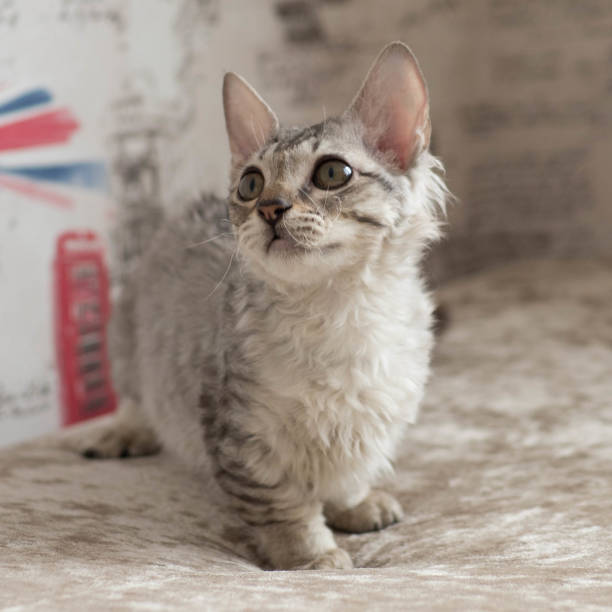Lambkin

History:
The Lambkin is a rare and relatively new breed developed in the early 1990s in the United States. It is the result of crossing two distinct breeds: the Munchkin, known for its short legs, and the Selkirk Rex, famous for its curly coat. The goal was to combine the dwarfism of the Munchkin with the plush, wavy coat of the Selkirk Rex, producing a small, curly-haired cat with a sweet temperament. The breed’s name “Lambkin” reflects its soft, lamb-like curls and endearing appearance. Though still experimental and not yet widely recognised by major cat associations, Lambkins have gained a niche following for their unique look and affectionate personality.
Size: Small to medium-sized cat
Height: 15–20 cm
Weight: 2–4.5 kg
Life Expectancy: 12 to 16 years

Breed Appearance:
The Lambkin is a compact, low-slung cat with a short-legged stature inherited from its Munchkin ancestry. Despite its small frame, it is well-proportioned and muscular. The most striking feature is its soft, curly coat, which can range from wavy to tightly ringleted, and is often likened to the wool of a lamb. Lambkins may be either long- or short-haired, with coats that come in a variety of colours and patterns. The head is rounded with full cheeks, a short nose, and large, expressive eyes. Ears are medium-sized and may have gentle curls at the tips. Their short legs do not hinder mobility, and they are surprisingly agile and active.
Health & Care:
As a crossbreed, the Lambkin inherits traits from both parent breeds and may face health concerns associated with each. Dwarfism from the Munchkin side can lead to spinal or joint issues, such as lordosis (spinal curvature) or pectus excavatum (sunken chest), although not all Lambkins are affected. Responsible breeders screen for these conditions. Their curly coats can trap dirt and oil more easily, requiring more consistent grooming. Regular vet check-ups, a balanced diet, and indoor living help keep Lambkins healthy. Though generally robust, close attention to mobility and coat condition is necessary for long-term care.

Living Conditions:
Lambkins adapt well to indoor living and are well-suited for apartments or smaller homes due to their size and moderate activity level. They enjoy climbing, playing, and exploring at their own pace but may not be as athletic as longer-legged breeds. These cats thrive on companionship and bond closely with their families, making them excellent pets for households with children, seniors, or other animals. Their friendly and gentle nature makes them good companions, though they prefer environments where they’re not left alone for extended periods. Providing cat trees, interactive toys, and cosy resting spots enriches their lives.
Grooming:
Grooming needs depend on coat length, but all Lambkins require regular brushing to maintain the health of their curly fur. Brushing two to three times a week helps prevent tangles, remove debris, and distribute natural oils. Bathing is occasionally necessary, especially if the coat becomes greasy. Use a gentle cat-specific shampoo to avoid damaging the curl. Routine care should also include nail trimming, ear cleaning, and dental hygiene. Lambkins generally enjoy grooming sessions, particularly if introduced to them from kittenhood, and their soft, curly coats are a pleasure to maintain with consistent care.

Advantages:
-
Lambkins are affectionate, gentle, and social, making them wonderful companions for families, seniors, and individuals alike.
-
Their small size and moderate energy levels make them well-suited to apartment living.
-
The breed’s unique curly coat and short-legged stature give it a distinct, charming appearance that sets it apart from other cats.
-
They are intelligent and curious, enjoying playtime and bonding with their humans.
-
Lambkins typically get along well with other pets and children, thriving in interactive households.
Disadvantages:
-
As a rare and experimental breed, Lambkins can be hard to find and may be expensive to purchase.
-
Their short legs may limit their jumping ability and could be linked to skeletal health issues.
-
The curly coat requires consistent grooming to prevent matting and buildup of oils or dirt.
-
Some individuals may inherit health concerns related to dwarfism, requiring extra veterinary attention.
-
Because of their affectionate nature, Lambkins may become lonely or anxious if left alone too often.







